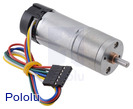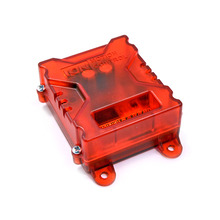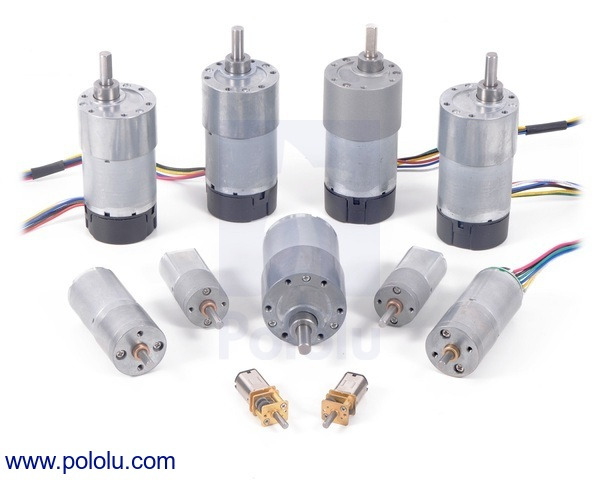This gearmotor consists of a low-power, 6 V brushed DC motor combined with a 498.87:1 metal spur gearbox. The gearmotor is cylindrical, with a diameter just under 25 mm, and the D-shaped output shaft is 4 mm in diameter and extends 12.5 mm from the face plate of the gearbox.
Special Order
Shipping from $9.90
+60 more from our supplier in 7-10 days
Our Code: MEC-30203
Supplier Link: [Pololu MPN:1591]
This gearmotor consists of a low-power, 6 V brushed DC motor combined with a 498.87:1 metal spur gearbox. The gearmotor is cylindrical, with a diameter just under 25 mm, and the D-shaped output shaft is 4 mm in diameter and extends 12.5 mm from the face plate of the gearbox. This gearmotor is also available with an integrated encoder.
Key specifications:
| voltage | no-load performance | stall extrapolation |
|---|---|---|
| 6 V | 12 RPM, 100 mA | 31 kg⋅cm (430 oz⋅in), 2.0 A |
These cylindrical brushed DC gearmotors are available in a wide range of gear ratios and with five different motors (two power levels of 6 V motors and three power levels of 12 V motors). The gearmotors all have the same 25 mm diameter case and 4 mm diameter gearbox output shaft, so it is generally easy to swap one version for another if your design requirements change (though the length of the gearbox tends to increase with the gear ratio). Each version is also optionally available with an integrated 48 CPR quadrature encoder. See the 25D metal gearmotor datasheet (2MB pdf) for more information, including detailed performance graphs for each gearmotor version. You can also use our dynamically sortable 25D gearmotor comparison table to search for the version that offers the best combination of speed, torque, and current draw for your particular application. A more basic comparison table is available below.
| Rated Voltage |
Motor Type |
Stall Current |
No-Load Current |
Gear Ratio | No-Load Speed (RPM) |
Extrapolated Stall Torque |
Max Power (W) |
 Without Encoder |
 With Encoder |
|
|---|---|---|---|---|---|---|---|---|---|---|
| (kg ⋅ cm) | (oz ⋅ in) | |||||||||
| 12 V | High-Power (HP) |
5.0 A | 250 mA w/o encoder 300 mA with encoder |
1:1 (no gearbox) | 10,000 | 0.4 | 5.5 | 10 | – | item #4840 |
| 4.4:1 | 2200 | 1.7 | 24 | 9.4 | item #3201 | item #4841 | ||||
| 9.7:1 | 1000 | 3.9 | 54 | 10 | item #3202 | item #4842 | ||||
| 20.4:1 | 500 | 7.4 | 100 | 9.4 | item #3203 | item #4843 | ||||
| 34:1 | 300 | 11 | 150 | 8.9 | item #3204 | item #4844 | ||||
| 47:1 | 220 | 15 | 210 | 8.4 | item #3205 | item #4845 | ||||
| 75:1 | 130 | 22 | 310 | – | item #3206 | item #4846 | ||||
| 99:1 | 100 | 29 | 400 | – | item #3207 | item #4847 | ||||
| 12 V | Medium-Power (MP) |
1.8 A | 80 mA w/o encoder 100 mA with encoder |
1:1 (no gearbox) | 8200 | 0.17 | 2.4 | 3.5 | – | item #4860 |
| 4.4:1 | 1800 | 0.71 | 10 | 3.2 | item #3225 | item #4861 | ||||
| 9.7:1 | 800 | 1.7 | 24 | 3.4 | item #3226 | item #4862 | ||||
| 20.4:1 | 380 | 3.2 | 44 | 3.1 | item #3227 | item #4863 | ||||
| 34:1 | 230 | 4.7 | 65 | 2.8 | item #3228 | item #4864 | ||||
| 47:1 | 170 | 6.4 | 89 | 2.8 | item #3229 | item #4865 | ||||
| 75:1 | 100 | 8.5 | 120 | 2.3 | item #3230 | item #4866 | ||||
| 99:1 | 79 | 11 | 150 | 2.3 | item #3231 | item #4867 | ||||
| 172:1 | 46 | 18 | 250 | 2.1 | item #3232 | item #4868 | ||||
| 227:1 | 35 | 24 | 330 | – | item #3233 | item #4869 | ||||
| 12 V | Low-Power (LP) |
0.9 A | 50 mA w/o encoder 60 mA with encoder |
1:1 (no gearbox) | 5600 | 0.14 | 1.9 | 1.8 | – | item #4880 |
| 4.4:1 | 1200 | 0.53 | 7.4 | 1.7 | item #3249 | item #4881 | ||||
| 9.7:1 | 580 | 1.3 | 18 | 1.8 | item #3250 | item #4882 | ||||
| 20.4:1 | 280 | 2.4 | 33 | 1.7 | item #3251 | item #4883 | ||||
| 34:1 | 170 | 3.7 | 51 | 1.6 | item #3252 | item #4884 | ||||
| 47:1 | 120 | 4.8 | 67 | 1.4 | item #3253 | item #4885 | ||||
| 75:1 | 75 | 7.1 | 99 | 1.4 | item #3254 | item #4886 | ||||
| 99:1 | 57 | 8.7 | 120 | 1.2 | item #3255 | item #4887 | ||||
| 172:1 | 33 | 13 | 180 | 1.1 | item #3256 | item #4888 | ||||
| 227:1 | 25 | 16 | 220 | 1.0 | item #3257 | item #4889 | ||||
| 378:1 | 15 | 23 | 320 | – | item #3258 | item #4890 | ||||
| 6 V | High-Power (HP) |
6.0 A | 420 mA w/o encoder 500 mA with encoder |
1:1 (no gearbox) | 10,000 | 0.3 | 4 | 7 | – | item #4800 |
| 4.4:1 | 2200 | 1.2 | 17 | 6.7 | item #1570 | item #4801 | ||||
| 9.7:1 | 1000 | 2.3 | 32 | 5.9 | item #1571 | item #4802 | ||||
| 20.4:1 | 480 | 4.8 | 67 | 5.9 | item #1572 | item #4803 | ||||
| 34:1 | 290 | 6.8 | 94 | 5.1 | item #1573 | item #4804 | ||||
| 47:1 | 210 | 9.1 | 130 | 4.9 | item #1574 | item #4805 | ||||
| 75:1 | 130 | 14 | 190 | 4.5 | item #1575 | item #4806 | ||||
| 99:1 | 99 | 15 | 210 | 3.9 | item #1576 | item #4807 | ||||
| 172:1 | 57 | 27 | 380 | – | item #1577 | item #4808 | ||||
| 6 V | Low-Power (LP) |
2.0 A | 100 mA w/o encoder 120 mA with encoder |
1:1 (no gearbox) | 6200 | 0.15 | 2.1 | 2.1 | – | item #4820 |
| 4.4:1 | 1300 | 0.63 | 8.7 | 2.1 | item #1581 | item #4821 | ||||
| 9.7:1 | 630 | 1.3 | 18 | 1.9 | item #1582 | item #4822 | ||||
| 20.4:1 | 290 | 2.5 | 35 | 1.9 | item #1583 | item #4823 | ||||
| 34:1 | 180 | 3.9 | 54 | 1.7 | item #1584 | item #4824 | ||||
| 47:1 | 130 | 4.8 | 67 | 1.5 | item #1585 | item #4825 | ||||
| 75:1 | 80 | 7.5 | 100 | 1.5 | item #1586 | item #4826 | ||||
| 99:1 | 61 | 9.1 | 130 | 1.4 | item #1587 | item #4827 | ||||
| 172:1 | 35 | 14 | 190 | 1.2 | item #1588 | item #4828 | ||||
| 227:1 | 27 | 17 | 240 | 1.1 | item #1589 | item #4829 | ||||
| 378:1 | 16 | 25 | 350 | – | item #1590 | item #4830 | ||||
| 499:1 | 12 | 31 | 430 | – | item #1591 | item #4831 | ||||
Note: The listed stall torques and currents are theoretical extrapolations; units will typically stall well before these points as the motors heat up. Stalling or overloading gearmotors can greatly decrease their lifetimes and even result in immediate damage. The recommended upper limit for continuously applied loads is 4 kg⋅cm (55 oz⋅in), and the recommended upper limit for intermittently permissible torque is 8 kg⋅cm (110 oz⋅in). Stalls can also result in rapid (potentially on the order of seconds) thermal damage to the motor windings and brushes; a general recommendation for brushed DC motor operation is 25% or less of the stall current.
In general, these kinds of motors can run at voltages above and below their nominal voltages (they can begin rotating at voltages as low as 1 V); lower voltages might not be practical, and higher voltages could start negatively affecting the life of the motor.
Exact gear ratio: ``(22×22×22×22×22×22×22×24) / (12×10×10×10×10×10×10×10) ~~ bb(498.87:1)``
The diagram below shows the dimensions of the 25D mm line of gearmotors (units are mm over [inches]). This diagram is also available as a downloadable PDF (171k pdf).
Warning: Do not screw too far into the mounting holes as the screws can hit the gears. We recommend screwing no further than 6 mm (0.24″) into the screw hole.
|
|
|
Alternatively, you could use our 4mm scooter wheel adaptor to mount many common scooter, skateboard, and inline skate wheels to the gearmotor’s output shaft as shown in the left picture below. For a general-purpose hex adaptor, consider our 12mm hex wheel adaptor, which lets you use this motor with many common hobby RC wheels as shown in the right picture below.
|
|
|
|
If you are looking for higher-level control interfaces, such as USB, RC, analogue voltages, I²C, or TTL serial, consider our Motoron motor controllers, Jrk motor controllers, or RoboClaw motor controllers; these controllers are available in various power levels several of which can handle the 25D mm metal gearmotors (we generally recommend a motor controller that can handle continuous currents above the stall current of your motor).
  |
Three Motoron M3H550 controllers being controlled by a Raspberry Pi. |
|---|
  |
Jrk G2 21v3 USB Motor Controller with Feedback. |
|---|
  |
RoboClaw 2×7A Motor Controller (V5B) in its included case. |
|---|
|
|
We offer a wide selection of metal gearmotors that offer different combinations of speed and torque. Our metal gearmotor comparison table can help you find the motor that best meets your project’s requirements.
 |
| Size: | 25D x 58L mm1 |
|---|---|
| Weight: | 96 g |
| Shaft diameter: | 4 mm2 |
| Gear ratio: | 498.87:1 |
|---|---|
| No-load speed @ 6V: | 12 rpm3 |
| No-load current @ 6V: | 0.10 A4 |
| Stall current @ 6V: | 2.0 A5 |
| Stall torque @ 6V: | 31 kg·cm5 |
| Motor type: | 6V, 2.0A stall (LP 6V) |
| Encoders?: | N |
This file contains 3D models (in the step file format) of the 25D mm gearmotors with and without encoders.
No! Stalls can result in rapid (potentially on the order of seconds) thermal damage to the motor windings and brushes; a general recommendation for brushed DC motor operation is 25% or less of the stall current, which means keeping continuously applied loads around 25% or less of the stall torque.
Additionally, for many of our gearmotors with high gear ratios, the extrapolated stall torque is beyond what the gearboxes are designed to handle, and a stall could instantly damage the gears. Make sure to keep applied loads within the published limits for your gearmotor.